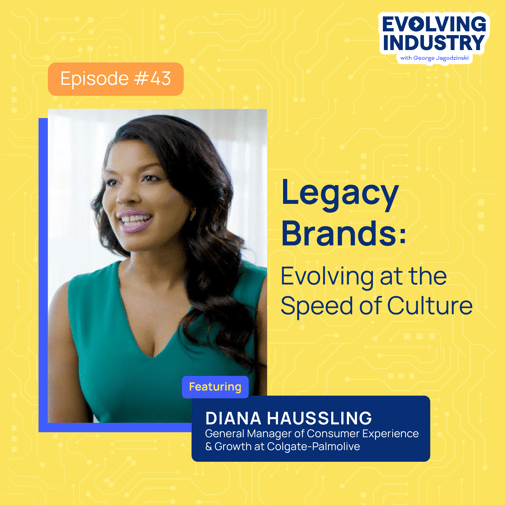Evolving Industry
How do centuries-old legacy brands maintain relevance while honoring the long-standing traditions that got them to where they are today?
In our interview with Diana Haussling, she put it simply — you must evolve at the speed of culture.
The General Manager of Consumer Experience & Growth at Colgate-Palmolive shared her unique insights on the challenges of balancing innovation with heritage in a fast-moving market.
Diana talked with us about:
- Finding the North Star that can future-proof your brand
- The importance of jumping on cultural moments
- Why understanding your strengths is a superpower
How Legacy Brands Cracked the Marketing Code
You could say Diana is a fan of legacy brands, having worked at companies like Hershey, Campbell Soup, and Colgate-Palmolive.
“I’m a lover of brands myself as a consumer,” she said. “I see the impact that they have on my life, but I also see the impact that they can have on us as humans and on the world.”
But as many business leaders know, nothing is guaranteed in a dynamic market in which only 25% of startups survive more than 15 years.
“To be relevant to consumers [for] generation after generation means that you've cracked the code for branding and marketing, having a product that really delivers on its promise,” Diana said.
Diana suggested that an organization’s brand promise is the foundation on which they must build to beat the odds and outlast the competition.
“Everything must be grounded in that North Star and where you're going. I think that's what helps organizations make those decisions around what we need to maintain, what we need to involve, and what we need to adapt.”
She also mentioned that having a balanced team of generalists and experts is critical to covering all the bases in a well-rounded marketing team.
“It’s not always going to be the traditional marketer that gets that role,” Diana said. “We're really investing in developing the best marketing organization that sets us up for success, not just this year, but [to] make sure we're future-proof for the next 10, 20, 200 years.”
Be in the Cultural Moment
Centuries-old legacy brands like Colgate-Palmolive have obviously been doing something right.
Yet, as the saying goes… change or die.
So how do these battle-tested companies maintain a happy marriage between innovation and conventional wisdom?
“You have to put a lot of extra work into making sure you stay nimble and [that] you're able to move with urgency and the speed of culture,” Diana said.
Of course, “culture” can mean many different things to different people. In this case, Diana argues that legacy branding starts within the business.
“First, you have to think about the culture of your organization, especially with Gen Z, who think and operate much differently than generations before them,” she said. “How do you take advantage of that? But also, how do you design a workplace and a culture that enables the best out of the teams that you’re in?”
Once you’ve secured a positive internal culture, then you must establish your brand’s place in your consumers’ culture.
To do this, Diana advocated for a customer-first approach.
“We love our brands, and we romance them, and we’re so focused on them that we want our brands to be the main character,” she suggested. “That main character energy doesn’t work within culture. We really have to set ourselves up to be the best friend of the consumer.”
Once you understand your product’s role in cultural conversations, you can work to gain the trust of your target audience.
“You start to show up differently,” Diana said. “It allows you to be proactively prepared… to jump on cultural moments that happen and be a part of them in a very authentic way.”
Know Your Weaknesses and Play to Your Strengths
It can be difficult for any brand (or person, for that matter) to acknowledge their shortcomings to a customer or client.
That’s why Diana believes it’s essential for every level of an organization to understand its strengths and capitalize on them.
“We’re all going to strive to be better and strive to work on our gaps, but where you really unlock your superpower is understanding your strengths.”
She implied that one of the worst things you can do is try to mimic everyone else in your market.
“If you’re trying to be like someone else, you’re going to fail because you’re never going to deliver.”
Once you’ve cemented your strengths, you can work on supplementing the cracks in your organization.
“When I’m designing a team, I already know where my gaps are,” Diana said.
Ultimately, if any brand will become a legacy in its own right, it starts with leaders recognizing that they can’t do it alone.
“[What] allows you to have the best path forward is the self-awareness and vulnerability that it takes to not only be a good leader but to actually deliver performance and results.”
Craving more? You can find this interview and many more by subscribing to Evolving Industry on Apple Podcasts, on Spotify, or here.
